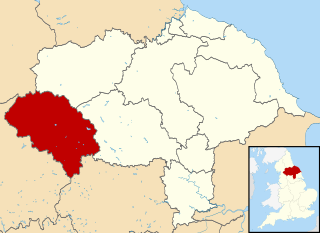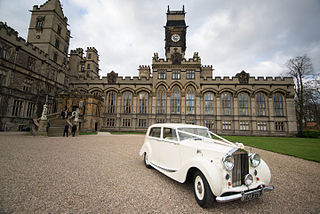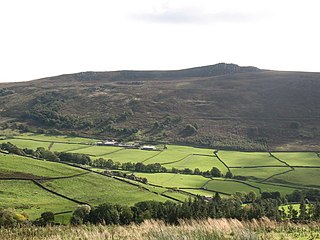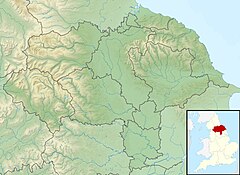
Bolton Abbey Estate in Wharfedale, North Yorkshire, England, takes its name from a 12th-century Augustinian monastery of canons regular, now known as Bolton Priory. The priory, which was closed in the 1539 Dissolution of the Monasteries ordered by King Henry VIII, is in the Yorkshire Dales, which lies next to the village of Bolton Abbey.

Craven was a non-metropolitan district in the west of North Yorkshire, centred on the market town of Skipton.

Grassington is a village and civil parish in North Yorkshire, England. The population of the parish at the 2011 Census was 1,126. Historically part of the West Riding of Yorkshire, and now in the lieutenancy area of North Yorkshire, the village is situated in Wharfedale, about 8 miles (10 km) north-west from Bolton Abbey, and is surrounded by limestone scenery. Nearby villages include Linton, Threshfield, Hebden, Conistone and Kilnsey.

Kilnsey is a small village in Wharfedale, North Yorkshire, England. It lies on the B6160 road, between the villages of Grassington and Kettlewell, near Arncliffe and just across the River Wharfe from Conistone. The village is 12 miles (19 km) north of Skipton and 3 miles (5 km) south of Kettlewell.

Carlton Towers in the civil parish of Carlton, 5 miles (8 km) south-east of Selby, North Yorkshire, England, is a very large Grade I listed country house, in the Gothic Revival style, and is surrounded by a 250-acre park.

Appletreewick is a village and civil parish in the Craven district of North Yorkshire, England, 6.5 miles (10.5 km) north-east of Skipton, 7 miles (11 km) from Skipton railway station and 16 miles (25.7 km) from Leeds Bradford International Airport.

Barden is a civil parish in the Craven district of North Yorkshire, England. It consists of the hamlet of Drebley and a few scattered houses in Wharfedale in the Yorkshire Dales. The parish also includes two areas of moorland, Barden Fell to the east of the River Wharfe and Barden Moor to the west of the river. Both moorlands are access land, and are popular with walkers. Barden Fell rises to the prominent peak of Simon's Seat, and Barden Moor includes two scenic 19th century reservoirs. Much of the parish is on the Bolton Abbey estate.

Burnsall is a village and civil parish in the Craven district of North Yorkshire, England. It is situated on the River Wharfe in Wharfedale, and is in the Yorkshire Dales National Park.

Embsay is a village in the Craven district of North Yorkshire, England. It is paired with the neighbouring hamlet of Eastby to form the civil parish of Embsay with Eastby. The parish population as of the 2011 census was 1,871.

Bolton Priory, whose full title is The Priory Church of St Mary and St Cuthbert, Bolton Abbey, is a Grade I listed parish church of the Church of England in the village of Bolton Abbey, within the Yorkshire Dales National Park in North Yorkshire, England. There has been continuous worship on the site since 1154, when a group of Augustinian canons moved from their original community in nearby village of Embsay and started construction of the present building, which is now situated within a scheduled monument under the Ancient Monuments and Archaeological Areas Act 1979. Despite the loss of most of the Priory buildings during the Dissolution of the Monasteries, the western half of the original nave was preserved so that the local parish could continue its worship there. There is today a full liturgical calendar, although a programme of other events, which formerly included the spring Blessing of the Lambs, the Bolton Priory Celebrity Organ Recitals, the Bolton Priory Mystery Play and the Bolton Priory Live Nativity, now only comprises the Bolton Priory Concert Series and the annual St Cuthbert lecture. The Priory is a member of the Greater Churches Network, and pre-Covid welcomed more than 160,000 visitors a year.

Skipton Castle is a Grade I Listed medieval castle in Skipton, North Yorkshire, England. It was built in 1090 by Robert de Romille, a Norman baron, and has been preserved for over 931 years.

Yockenthwaite is a hamlet in the Craven district of North Yorkshire, England. It lies in the Langstrothdale valley in the Yorkshire Dales National Park. Historically part of the West Riding of Yorkshire, Yockenthwaite is 20 miles (32 km) north of Skipton and 8 miles (13 km) south of Hawes. The name of the hamlet is said to derive from Eoghan's clearing in a wood.

Appleby Castle is in the town of Appleby-in-Westmorland overlooking the River Eden. It consists of a 12th-century castle keep which is known as Caesar's Tower, and a mansion house. These, together with their associated buildings, are set in a courtyard surrounded by curtain walls. Caesar's Tower and the mansion house are each recorded in the National Heritage List for England as a designated Grade I listed building. The uninhabited parts of the castle are a scheduled ancient monument.
Weston is a village and civil parish in the former Harrogate district of North Yorkshire, England. The village is 1.2 miles (2 km) north–west of Otley and near the River Wharfe which forms the boundary between North and West Yorkshire. The name is from Old English and means western enclosure, farmstead or village.

Simon's Seat is a peak in the Yorkshire Dales in northern England. It is a prominent outcrop of millstone grit on the eastern side of Wharfedale. Although only 485 metres (1,591 ft) high, the extensive views from the summit make it a popular destination for walkers.

Lady Anne's Way is a 100-mile (160 km) hiking route between Skipton and Penrith in Northern England. The trail is punctuated by houses and towers once owned by the Clifford family, but is named after Lady Anne Clifford who renovated and repaired the buildings in the 17th century. The route goes through Grassington, Buckden, Askrigg, Garsdale Head, Kirkby Stephen, Great Ormside, Appleby-in-Westmorland and Penrith.

The Priest's House, formerly known as Barden Tower Farmhouse, is a historic building in Barden, Craven, a village near Skipton in North Yorkshire, in England.
Barden Old Chapel, also known as Barden Tower Chapel or Barden Church, is a historic building in Barden near Skipton in North Yorkshire, in England.

St Michael and All Angels is a parish church in the Church of England in Hubberholme, North Yorkshire. It is a Grade II* listed building. The church, and the neighbouring George Inn, were favourite locations of the author J. B. Priestley, whose ashes are buried in the churchyard.























